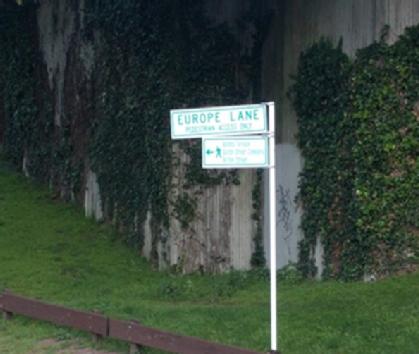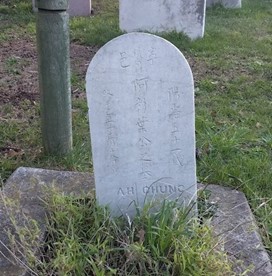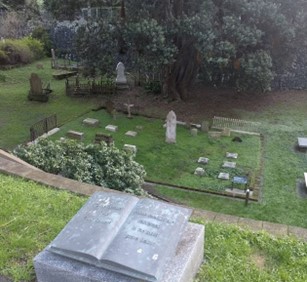Down Under: Reflections on a New Zealand Cemetery on the Occasion of the First "Europe in the Making" Lecture for the 2022-23 Academic Year
Published 7 October 2022, Michael Bycroft
I thought I was done with early modern European history. Not for good, but perhaps for two or three weeks. I was separated from Europe by ten thousand miles and two weeks in a quarantine hotel. I had just finished marking the last batch of Europe in the Making essays for the year. It was June, but the weather was getting colder, not hotter. The pōhutukawa trees in Wellington, the capital city of Aotearoa New Zealand, had lost their red flowers several months previously.
But then I saw this:

So I decided to take a walk down Europe Lane. And what I saw was something like a microcosm of European history.
The lane leads to the Bolton Street Cemetery, whose history is neatly summarised on an information board:
"A single, shared town cemetery, rather than individual church graveyards, was a modern concept in England in 1840. This early cemetery, created for the new Wellington colony, was to uphold these liberal ideals.
Anglicans, Roman Catholics, and Jews, however, still wanted separate areas of consecrated ground, so the cemetery became divided into Jewish, Anglican and ‘Public’ areas. The Roman Catholic cemetery is located in Mount Street, Kelburn [a few hundred metres from the Bolton Street Cemetery].
The history of colonisation is captured in the headstones. Those buried include soldiers of regiments charged with defending the new colony, large settler families, politicians and community leaders who were shaping the future of this far-flung colony…Deaths from disease, accident and skirmish recall the difficulties [they] faced."
I learn elsewhere that the cemetery contains graves of Māori (indigenous) people as well as Pakeha (European) people. I stumble upon a gravestone covered in Chinese characters.

As I later learn, this is the grave of Ye Ah Zhang, a seaman from Henan Province who died in 1889 at the age of 51 and whose funeral procession “included 10 carriages of mourners and was attended by many spectators” (with thanks to Anne GerritsenLink opens in a new window and Friends of Bolton Street Cemetery).
(And yes, there’s even a Bycroft: Robert, who died in 1869 aged 81.)
A typical colonial cemetery, perhaps. But the story took a strange turn in the twentieth century, when the cemetery was “bisected by a motorway,” as the information board explains:
"Destruction of the cemetery for the Wellington Motorway in the 1960s was resisted by action groups. Although they failed to halt the intrusion, they succeeded in elevating the status of this cemetery to a significant historic site and recreation park for the city.
During motorway excavations over 3,700 burials were exhumed and reinterred in a vault under the Memorial Lawn. Their headstones were re-located within the appropriate sectors of the cemetery."
In other words, the Memorial Lawn is a graveyard for a graveyard—it is filled with relocated bones and decorated with the remains of unidentified gravestones.

The tree behind the Memorial Lawn is a pine tree, another European import. This specimen is enormous, gnarled, and has a settled look. By contrast, the pines on a nearby hillside are brown and dead, casualties of a deliberate effort to replace imported species with native ones—a kind of arboreal decolonisation.
The history of Europe Lane might be traced right up to 2016, when the path received its current name in recognition of “the excellent state of the relationship between the EU and New Zealand,” in the words of the European Union website. The naming happened on June 23, 2016, the date of the Brexit referendum in Britain. Five years and one day afterwards, on June 24, 2021, I came across the lane while trying to avoid European history.
The cemetery is not “early modern” in the chronological sense, but it has an early modern flavour. It is shaped by confessional disputes between Catholics, Protestants, and Jews, and by shaky steps towards religious toleration. It is the product of settler colonialism, with its voyages, violence, naïve good intentions, and encounters between disparate cultures, both human and non-human. Its later history is marked by the sudden irruption of modernity (“bisected by motorway”) and by the uneasy co-existence of the old and the new. And there is something supernatural about it—the disinterred bodies, the cemetery-within-a-cemetery, the eerie calm in the middle of a busy city.
It is a reminder that the past, like a ghost, can rise up and ask hard questions when you least expect it.
